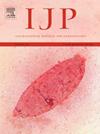Microinvertebrate consumption rates of Fasciola hepatica miracidia are not affected by alternate food
IF 3.2
2区 医学
Q1 PARASITOLOGY
引用次数: 0
Abstract
The liver fluke (Fasciola hepatica) is a significant parasite of the global livestock industry, leading to negative economic and animal welfare impacts. Control of F. hepatica is becoming increasingly difficult as many liver fluke populations are developing resistance to commonly used anthelmintics. Additional or alternate control methods are, therefore, required. Microinvertebrates such as those of the order Cyclopoida and subclass Ostracoda are common organisms found in the same aquatic habitats as F. hepatica’s intermediate snail host. We explore whether these microinvertebrates are effective predators of F. hepatica miracidia. We experimentally determined a) the consumption rates of miracidia by the two microinvertebrate groups, b) the form of functional feeding response displayed by each and c) whether inclusion of an alternate food source altered miracidial predation patterns. We find that cyclopoids and ostracods feed on miracidia and that where a statistically supported fit was found, the functional feeding response for both microinvertebrates was type II. Further, miracidial consumption by either microinvertebrate did not decline significantly in the presence of alternate prey. Our results suggest that cyclopoids and ostracods are both effective predators of F. hepatica and therefore have the potential as F. hepatica biocontrol agents. An important next step will be to explore what impact such predation has on the infection dynamics of the adult fluke in the definitive host.

微型无脊椎动物对微小肝片吸虫的摄取率不受替代食物的影响。
肝吸虫(肝片吸虫)是全球畜牧业的一种重要寄生虫,对经济和动物福利造成负面影响。控制肝吸虫正变得越来越困难,因为许多肝吸虫种群正在对常用的驱虫药产生耐药性。因此,需要额外的或替代的控制方法。微型无脊椎动物,如cyclopoda目和介形虫亚纲的无脊椎动物,是与肝螺旋体的中间蜗牛宿主在同一水生栖息地中发现的常见生物。我们探讨了这些微型无脊椎动物是否是微小肝藻的有效捕食者。我们通过实验确定了a)两个微型无脊椎动物群体对miracidia的消耗率,b)每种动物表现出的功能性进食反应形式,以及c)替代食物来源是否改变了miracidia的捕食模式。我们发现,摆线虫和介形虫以miracidia为食,并且在统计支持的拟合中发现,这两种微型无脊椎动物的功能性摄食反应都是II型。此外,在交替猎物存在的情况下,任何一种微型无脊椎动物的微小消耗都没有显著下降。本研究结果表明,摆轮虫和介形虫都是肝单胞菌的有效捕食者,因此具有作为肝单胞菌生物防治剂的潜力。一个重要的下一步将是探索这种捕食对最终宿主成年吸虫的感染动力学有什么影响。
本文章由计算机程序翻译,如有差异,请以英文原文为准。
求助全文
约1分钟内获得全文
求助全文
来源期刊
CiteScore
8.40
自引率
2.50%
发文量
76
审稿时长
23 days
期刊介绍:
International Journal for Parasitology offers authors the option to sponsor nonsubscriber access to their articles on Elsevier electronic publishing platforms. For more information please view our Sponsored Articles page. The International Journal for Parasitology publishes the results of original research in all aspects of basic and applied parasitology, including all the fields covered by its Specialist Editors, and ranging from parasites and host-parasite relationships of intrinsic biological interest to those of social and economic importance in human and veterinary medicine and agriculture.

 求助内容:
求助内容: 应助结果提醒方式:
应助结果提醒方式:


